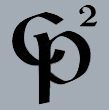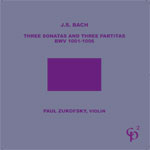
THREE SONATAS AND THREE PARTITAS
BWV 1001-1006
PAUL ZUKOFSKY, violin

 |
J.S. BACH THREE SONATAS AND THREE PARTITAS BWV 1001-1006 PAUL ZUKOFSKY, violin |
 |
Violinistically speaking, the primal problem of Bach's Three Sonatas and Three Partitas (for unaccompanied violin) is still that of finding a consistent system of bowing that clarifies the counterpoint while remaining physically practicable. Unfortunately, the movements that present the greatest difficulty in this respect (the fugues) have the least percentage of original bowing indications. This led me to believe that a system was being used which Bach thought so obvious that it was unnecessary to indicate bowings. In looking for this system I came upon two principles which I think are basic to the bowing of these works. These are: (a) the change of bow is determined by the longest single note, whether that note be in subject or countersubject, thus building up the interval content; (b) the stemming (in the manuscript) of the four note chords is indicative of the direction of the break. The first of these principles I have managed to follow almost without fail; the second slightly less so. As regards the movements which are more carefully marked. I decided to consistently follow the original bowings and succeeded in doing this with about a dozen exceptions in all six works. This was not a problem as over the years that I had studied and performed these works I had gradually come to use more and more of the original indications, as I found them increasingly integral to the style. I have also concentrated on finding a different solution to what is at once the binding strength as well as the greatest weakness of most baroque music — the rhythmical redundance. What I have arrived at is not the romantic definition of rubato, but rather a polyrhythmic view of Bach, predicated on the basic irrelevancy of the bar-line. The fugue of the a minor sonata is a good example of the systematic rebarring I believe is necessary to counteract the squareness inherent in the written (as opposed to aural) scores. The composite rhythm of the first 8 bars of the a minor fugue as written is: This is quite dull from a rhythmic point of view, but if we rebarred it to In this instance it is the placement of the pair of
being stressed as marked become instead: Could this rebarring be a large part of what CPE Bach really meant by "when the execution is such that one hand seems to play against the bar and the other strictly with it, it may be said that the performer is doing everything that can be required of him". Versuch III/28 (p. 161)* It certainly allows for the durational evenness that he requires in his previous sentence. PZ * Essay on the True Art of Playing Keyboard Instruments, CPE Bach translated and edited by
William J. Mitchell; Copyright, 1949, by W.W. Norton & Company, Inc., New York.
Sources: facsimile of the manuscript + Neue Bach Ausgabe; Baerenreiter Verlag. All recordings were made at the Vanguard Studios at 208 West 23rd Street, NYC, during 1971-72. They were engineered by Jeff Zaraya, among others, and originally released on Vanguard Recording Society Stereo VSD 71194/6. In 2005, the recordings were remixed and mastered (under the supervision of Paul Zukofsky) by Paul Zinman at SoundByte Productions, Inc., NYC. CP2118-119 |
|||||||||||||||||||||||||||||||||||||||||||||||||||||||||||||||||||||||||||||||||||||||||||||||||||||||||||||||||||||||||||||||||||||||